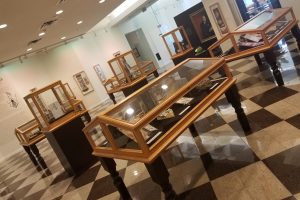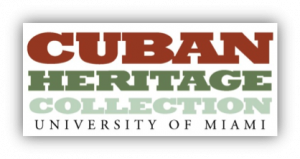Posted March 24, 2019
By ADAM SPECTOR
Most students are familiar with the University of Miami’s Lowe Art Museum on campus, however, not everybody is aware that there is a small museum-like space on the second floor of the Richter Library. This small and obscure exhibit area and archive is called The Cuban Heritage Collection.

The current exhibit is titled, “Illuminating Women: Representations and Narratives from Ediciones Vigia.” This collection consists of Cuban artwork made from books from Ediciones Vigia, a Cuban publisher.
Amanda Moreno, an archivist for the Cuban Heritage Collection, explained that in addition to being made from books published by Ediciones Vigia, the artwork on display in some way connects to females.
“The exhibit’s focus is on how women are represented in that publisher, so we’ve chosen books that are related because they are either drawn by women are designed by women, or the text inside it was written by a female author, or if women are the subject matter of the book,” Moreno said. “So that’s the premise of the exhibit.”

While the current exhibit is an art exhibit, the Cuban Heritage Collection carries far more than just Cuban artwork.
Dr. Martin Tsang, curator of the Cuban Heritage Collection and the Latin American Collections, said this is currently the most extensive collection of materials on or about Cuba that is located outside of Cuba.
Moreno explained that the collection is not a museum, as the exhibits are only changed roughly twice a year and only showcases 40 to 50 artifacts at a time.
“We’re not technically a museum; we’re a library archive that collects on Cuba and the Cuban Diaspora,” Moreno said. We collect all that’s related to Cuba or the Diaspora from the colonial period to the present.”
Tsang elaborated on what The Cuban Heritage Collection collects.
“We collect as much as we can, different types of things that speak to Cuba,” Tsang said. The collection includes books, newspapers, journals, maps, photos, artist books and also what we call manuscripts and papers,” Tsang stated. “So, for example, if a prominent professor, a Cuban professor, or business acumen business wants to donate their papers, their life work, for example, written records, that notes, their diaries, their correspondence, we will also have those here. So we collect things that are published, but also things that are not published as well and it can be in various formats. We also have some art, which happens to be on display now.”
Tsang then explained why there are no windows in the showroom.
“It’s an exhibition space, so it’s designed to showcase a few of our materials at a time,” Tsang said. “The temperature and light are carefully controlled to preserve the objects, so they’re not exposed to too much light, and then not exposed to too high or low temperatures, which preserves documents and objects for future generations.”
Moreno estimates the Cuban Heritage Collection currently has over 50,000 books and periodicals and more than 700 archival collections of various sizes. In addition to this, the collection has lent out artifacts to a number of museums across the country including the Smithsonian. Despite its massive collections, the exact total value is not known, but it was confirmed to be a lot.
“Well, there’s two types of value. There’s economic value as well as research value and often what’s of value to us has research value that doesn’t have much of a price tag to it,” Tsang said. “I would say that one of our most valuable single objects would be a book containing hand-painted manuscripts, which is valued at around a million, but we also have priceless things that are irreplaceable. The collection in total has not been yet been valued and we need to have a value for insurance purposes, but it is in the hundreds of millions of dollars.”
The Cuban Heritage Collection is considered a part of the Richter Library and is funded by the University of Miami. This archive is intended to aid research and teach people about Cuba in its entirety.
Ryan Grille, 23, a UM student of Cuban heritage, views the collection as a good way of teaching people about Cuba before and during Castro’s reign.
“I’ve never actually been to Cuba, so I can’t say ‘oh this reminds me of Cuba,’ but I can tell you that a lot of what’s brought back (artwork) from Cuba by relatives looks a lot like this,” Grille said.
Grille views the historical collection as being most important for what Cuba was before it became a communist country.
“It’s pretty difficult for people in Cuba. They don’t have air conditioning, they are still driving ’50s cars and people work for very little pay. Some of the comforts that we take for granted here in the United States aren’t the case for Cubans,” Grille said. “The Cuban Heritage Collection is especially important because it also represents what Cuba was and not just Cuba what it is today.”
